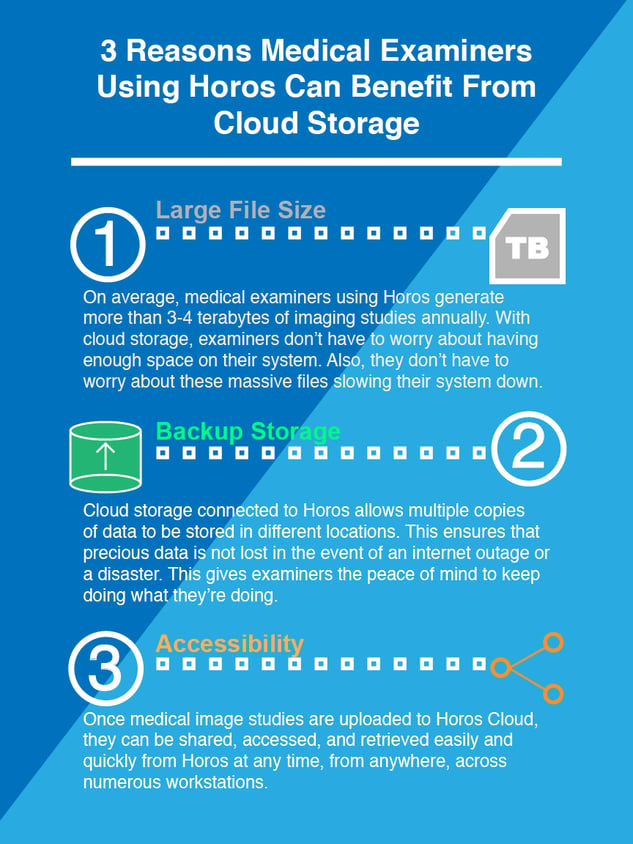
Reason #1: Their Images Are Huge
Advanced modalities like CT scanners and MRIs are quickly becoming an important part of the medical examiner's tool kit. Often their scans cover large regions of their subject’s anatomy and denser, higher resolution images can be taken as the need to mitigate radiation is not relevant since the subject is no longer living. These factors result in enormous image file sizes – ranging to upwards of tens of gigabytes and beyond. Studies this large can be challenging to work with as they hog up bandwidth and processing power. Multiply that by the compounding number of subjects a busy medical examiner assesses each day and you have created a set of data that requires effective storage, careful management, and increased accessibility.
On average, we have seen medical examiners using Horos generate more than 3-4 terabytes of imaging studies annually. With the requirement to maintain this historical data - often in perpetuity - it is hard for medical examiners’ offices to keep up with their ever-expanding storage requirements. That’s one of the major reasons why medical examiners can benefit from using a cloud storage solution that integrates with Horos.
Reason #2: They Need Backup Storage
Medical examiners must make sure that their images are not accidentally deleted or altered. Often these files become the core evidence in criminal matters. It is important for the examiner to maintain a clear chain of custody as well as resilient storage not subject to loss or defect. If anything were to happen to their scans, they cannot be redone… for obvious reasons. This makes it even more vital that they have a reliable backup storage solution. Whether you are using a physical storage device like a local onsite PACS, an image router, a physical hard drive, a filing cabinet, or storing all your patients' images locally in Horos – you are at risk of losing your data.
Rather than run the risk of losing data due to a natural or human caused disaster or, even more common, human error, medical examiners are turning more and more to the cloud as a way to ensure the resiliency of their data. We all know that technology can fail, and so can humans. Planning in advance for a catastrophe is a best practice of most medical examiner offices.
Cloud storage connected to Horos provides both the resiliency of multiple copies of data being stored in different locations, but perhaps more importantly maintains this data in geographically diverse physical locations ensuring that even a widespread weather event or disaster would not impact their ability to retrieve this important data.
Reason #3: Sharing, Access, and Mobility
Once medical image studies are uploaded to the cloud, in addition to piece-of-mind that your images will be there when you need them, they can also be queried and retrieved easily and quickly from Horos at anytime, from anywhere across numerous workstations. There is no need to search multiple devices or storage caches. All of your historical data is in one location, available whenever required. Even large files can be accessed in a sufficiently fast manner to serve most office needs. This increases flexibility as you can now view your uploaded scans even when you are not in your local office.
Sharing these enormous files when they are required for collaboration, necessary for forensic specialists, or even when they are required for trial, can be quite a burden without the proper architecture. Due to the file size, many studies are too large to fit on a CD or DVD making it even harder to send or share. Studies stored in the cloud can be much more easily shared and made available for download if necessary without having to burn them to a disk. Instead, a file can be made accessible to anyone that requires it by providing them with a secure log-in to your account, which they can use to access medical imaging studies from wherever they are located, without the need to transport the bulky file itself.
Final Thought
Medical examiners have unique and aggressive requirements for their storage and availability of medical images. Using the cloud as the next generation of medical imaging storage can ease the increasing burdens and workloads of medical examiners as they struggle to capture, store, access, and share these critically important medical records. And that's why medical examiners should consider using cloud storage to ease their medical image management.





